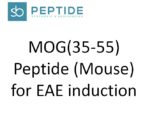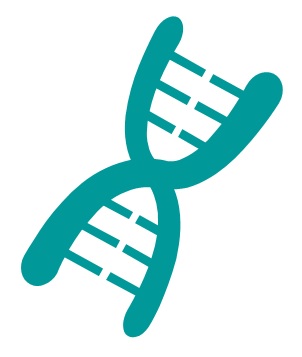MOG peptides pool
MOG peptides pool for antigen-specific CD4+ and CD8+ T-cells stimulation
Multiple sclerosis (MS)
Multiple sclerosis (MS) is a condition in which autoimmune cells wrongly attack the layer, surrounding and protecting the nerves, called myelin sheath. The inflammatory substances released by autoreactive T-cells, specific for myelin antigens, such as Myelin Oligodendrocyte Glycoprotein (MOG), damage and scar the sheaths, as well as the oligodendrocytes (myelinating cells of the CNS) and underlying nerves, eventually.
The destruction of the insulating material, aiming to preserve the action potential passing through the axon of the neuron, consequently leads to signal slowdown and disruption.
Human Myelin-oligodendrocyte glycoprotein (MOG) protein
Human MOG (UniProtKB – Q16653) is part of the 15-30% proteins constituting the myelin sheath. Even though its primary role is not yet known, its structural features suggest its function as « adhesion molecule » that would be necessary for the structural integrity of the myelin sheath.
Besides, its involvement in the completion and/or maintenance of cell-cell communication was hypothesized.
SB-PEPTIDE MOG pool
SB-PEPTIDE’s MOG pool has been developed for specific stimulation of antigen-specific CD4+ and CD8+ T-cells in vitro.
SB-PEPTIDE offers Myelin Oligodendrocyte Glycoprotein pool composed of 59 15-mer sequences with 11 amino acids overlap, covering the entire sequence of the human protein.
MOG pool is 100% made in France with an average purity of peptides around 70%. The company ensures a strict control of production with batch-to-batch reproducibility to deliver endotoxin free aliquots, verified by LAL.
MOG peptides pool applications
Incubation of Peripheral Blood Mononuclear Cells (PBMC) with SB-PEPTIDE’s MOG pool leads to the secretion of effector cytokines and upregulation of activation markers to detect and isolate myelin-specific T-cells.
After stimulation, CD4+ and CD8+ T-cells can be used for various applications, including:
- The detection and analysis of MOG-specific T-cells in PBMC (visit our PBMC Isolation Protocol webpage)
- The isolation of viable MOG-specific CD4+ and CD8+ T-cells for generation of T-cell lines by expansion
- The generation of MOG-specific effector/memory T-cells from naive T-cells
- The pulsing of antigen-presenting cells (APC)


Technical specifications
 |
Sequences: 59 peptides from Human MOG protein – MOG Peptides Pool sequences |
 |
Purity : Crude (~70%) |
 |
Made in France |
 |
Counter-Ion : TFA Salts |
 |
Delivery format : Freeze dried in propylene 2 mL microtubes |
 |
Other names : MOG-59, MOG pool T-cells activator |
 |
Endotoxin free |
 |
Bulk available, customization available, individual peptides available |
MOG Peptides Pool price
| Product catalog | Size | Price € HT | Price $ USD |
| SB286-15NM | 15 nmol (~25µg/peptide) | 275 | 344 |
| SB286-60NM | 60 nmol (~100µg/peptide) | 963 | 1203 |
References
Frontiers in Immunolog. 2021 Jun 16; 12. doi: https://doi.org/10.3389/fimmu.2021.679770
Regulatory T Cells Increase After rh-MOG Stimulation in Non-Relapsing but Decrease in Relapsing MOG Antibody-Associated Disease at Onset in Children
Background: Myelin oligodendrocytes glycoprotein (MOG) antibody-associated disease (MOGAD) represent 25% of pediatric acquired demyelinating syndrome (ADS); 40% of them may relapse, mimicking multiple sclerosis (MS), a recurrent and neurodegenerative ADS, which is MOG-Abs negative.
Aims: To identify MOG antigenic immunological response differences between MOGAD, MS and control patients, and between relapsing versus non-relapsing subgroups of MOGAD.
Methods: Three groups of patients were selected: MOGAD (n=12 among which 5 relapsing (MOGR) and 7 non-relapsing (MOGNR)), MS (n=10) and control patients (n=7). Peripheral blood mononuclear cells (PBMC) collected at the time of the first demyelinating event were cultured for 48 h with recombinant human (rh)-MOG protein (10 μg/ml) for a specific stimulation or without stimulation as a negative control. The T cells immunophenotypes were analyzed by flow cytometry. CD4+ T cells, T helper (Th) cells including Th1, Th2, and Th17 were analyzed by intracellular staining of cytokines. Regulatory T cells (Tregs, Foxp3+), CD45RA-Foxp3+ Tregs and subpopulation naive Tregs (CD45RA+Foxp3int), effector Tregs (CD45RA-Foxp3high) and non-suppressive Tregs (CD45RA-Foxp3int) proportions were determined.
Results: The mean onset age of each group, ranging from 9.9 to 13.8, and sex ratio, were similar between MOGR, MOGNR, MS and control patients as analyzed by one-way ANOVA and Chi-square test. When comparing unstimulated to rh-MOG stimulated T cells, a significant increase in the proportion of Th2 and Th17 cells was observed in MOGAD. Increase of Th17 cells was significant in MOGNR (means: 0.63 ± 0.15 vs. 1.36 ± 0.43; Wilcoxon-test p = 0.03) but not in MOGR. CD4+ Tregs were significantly increased in MOGNR (means: 3.51 ± 0.7 vs. 4.59 ± 1.33; Wilcoxon-test p = 0.046) while they decreased in MOGR. CD45RA-Foxp3+ Tregs were significantly decreased in MOGR (means: 2.37 ± 0.23 vs. 1.99 ± 0.17; paired t-test p = 0.021), but not in MOGNR. MOGR showed the highest ratio of effector Tregs/non suppressive-Tregs, which was significantly higher than in MOGNR.
Conclusions: Our findings suggest that CD4+ Th2 and Th17 cells are involved in the pathophysiology of MOGAD in children. The opposite response of Tregs to rh-MOG in MOGNR, where CD4+ Tregs increased, and in MOGR, where CD45RA-Foxp3+ Tregs decreased, suggests a probable loss of tolerance toward MOG autoantigen in MOGR which may explain relapses in this recurrent pediatric autoimmune disease.
Chin Med J (Engl). 2019 Dec 20; 132(24): 2934-2940. doi: https://doi.org/10.1097%2FCM9.0000000000000551
Characterization of myelin oligodendrocyte glycoprotein (MOG)35–55-specific CD8+ T cells in experimental autoimmune encephalomyelitis
Background:
The pathogenesis of multiple sclerosis (MS) is mediated primarily by T cells, but most studies of MS and its animal model, experimental autoimmune encephalomyelitis (EAE), have focused on CD4+ T cells. The aims of the current study were to determine the pathological interrelationship between CD4 and CD8 autoreactive T cells in MS/EAE.
Methods:
Female C57BL/6 mice (n = 20) were induced by myelin oligodendrocyte glycoprotein (MOG)35–55 peptide. At 14 days after immunization, T cells were isolated from the spleen and purified as CD4+ and CD8+ T cells by using CD4 and CD8 isolation kits, and then the purity was determined by flow cytometric analysis. These cells were stimulated by MOG35–55 peptide and applied to proliferation assays. The interferon-gamma (IFN-γ) and interleukin (IL)-4 secretion of supernatant of cultured CD4+ and CD8+ T cells were measured by enzyme-linked immunosorbent assays (ELISA). For adoptive transfer, recipient mice were injected with MOG35–55-specific CD8+ or CD4+ T cells. EAE clinical course was measured by EAE score at 0–5 scale and spinal cord was examined by staining with hematoxylin and eosin and Luxol fast blue staining.
Results:
CD8+CD3+ and CD4+CD3+ cells were 86% and 94% pure of total CD3+ cells after CD8/CD4 bead enrichment, respectively. These cells were stimulated by MOG35–55 peptide and applied to proliferation assays. Although the CD8+ T cells had a generally lower response to MOG35–55 than CD4+ T cells, the response of CD8+ T cells was not always dependent on CD4. CD8+ T cell secreted less IFN-γ and IL-4 compared with CD4+ T cells. EAE was induced in wildtype B6 naïve mice by adoptive transfer of MOG35–55-specific T cells from B6 active-induced EAE (aEAE) mice. A similar EAE score and slight inflammation and demyelination were found in naive B6 mice after transferring of CD8+ T cells from immunized B6 mice compared with transfer of CD4+ T cells.
Conclusion:
Our data suggest that CD8+ autoreactive T cells in EAE have a lower encephalitogenic function but are unique and independent on pathogenic of EAE rather than their CD4+ counterparts.
Keywords: Autoimmune, CD8-Positive T-Lymphocytes, Encephalomyelitis, Experimental, Multiple Sclerosis, Myelin-Oligodendrocyte Glycoprotein.
J Autoimmun. 1998 Aug;11(4):287-99. doi: https://doi.org/10.1006/jaut.1998.0202
T-cell responses to myelin antigens in multiple sclerosis; relevance of the predominant autoimmune reactivity to myelin oligodendrocyte glycoprotein
Until recently, the search for the ‘culprit’ autoantigen towards which deleterious autoimmunity is directed in multiple sclerosis (MS) centered mostly on myelin basic protein (MBP) and proteolipid (PLP), the two most abundant protein components of central nervous system (CNS) myelin, the target tissue for the autoimmune attack in MS. Although such research has yielded important data, furthering our understanding of the disease and opening avenues for possible immune-specific therapeutic approaches, attempts to unequivocally associate MS with MBP or PLP as primary target antigens in the disease have not been successful. This has led in recent years to a new perspective in MS research, whereby different CNS antigens are being investigated for their possible role in the initiation or progression of MS. Interesting studies in laboratory animals show that T-cells directed against certain non-myelin-specific CNS antigens are able to cause inflammation of the CNS, albeit without expression of clinical disease. However, reactivity to these antigens by MS T-cells has not been demonstrated. Conversely, reactivity by MS T-cells to non-myelin-specific antigens such as heat shock proteins, could be observed, but the pathogenic potential of such reactivity has not been corroborated with the encephalitogenicity of the antigen. More relevant to MS pathogenesis may be, as we outlined in this review, the autoimmune reactivity directed against minor myelin proteins, in particular the CNS-specific myelin oligodendrocyte glycoprotein (MOG). Here, we review the current knowledge gathered on T-cell reactivity to possible target antigens in MS in the context of their encephalitogenic potential, and underline the facets which make MOG a highly relevant contender as primary target antigen in MS, albeit not necessarily the only one.
